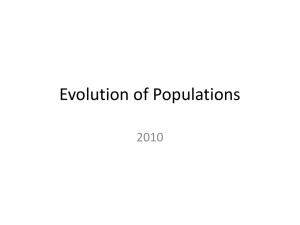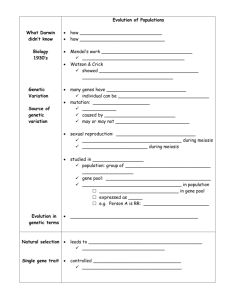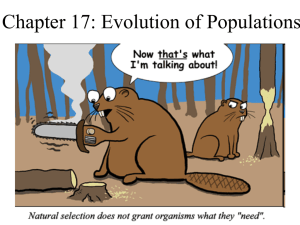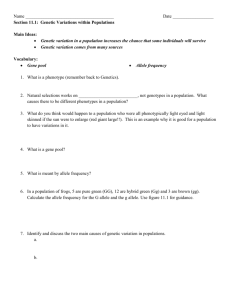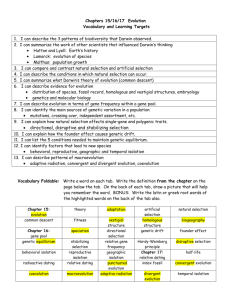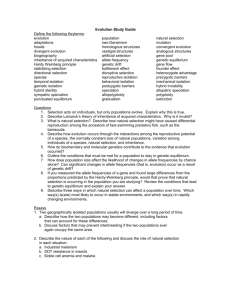Unit 6: Evolution Population Genetics (Chapter 11)
advertisement
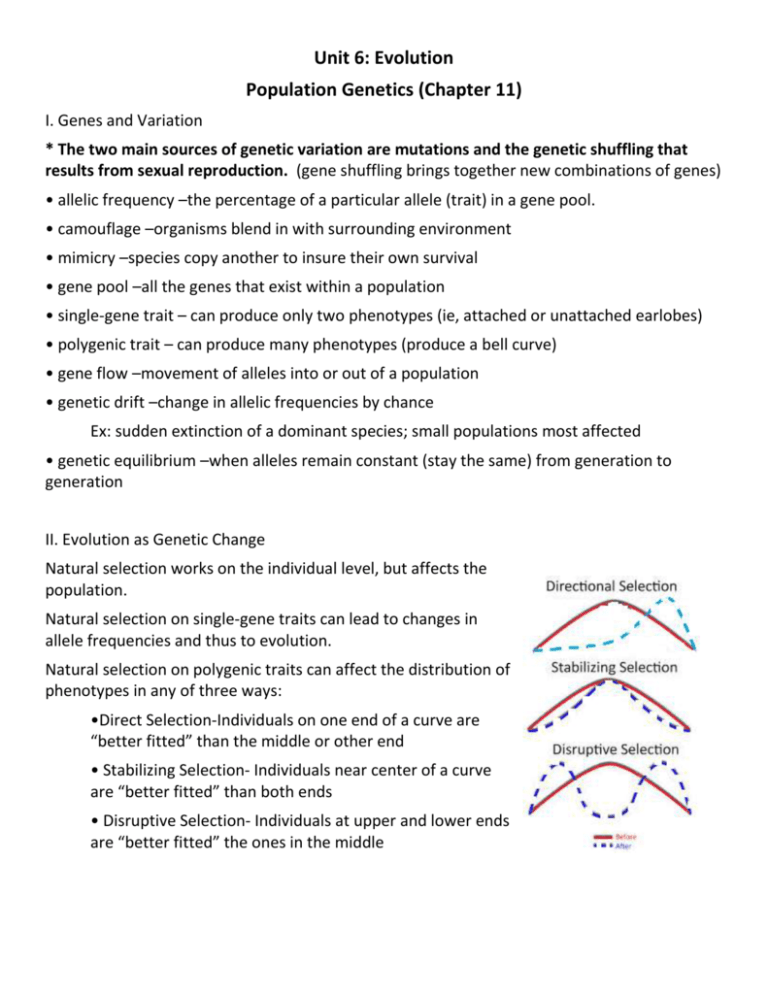
Unit 6: Evolution Population Genetics (Chapter 11) I. Genes and Variation * The two main sources of genetic variation are mutations and the genetic shuffling that results from sexual reproduction. (gene shuffling brings together new combinations of genes) • allelic frequency –the percentage of a particular allele (trait) in a gene pool. • camouflage –organisms blend in with surrounding environment • mimicry –species copy another to insure their own survival • gene pool –all the genes that exist within a population • single-gene trait – can produce only two phenotypes (ie, attached or unattached earlobes) • polygenic trait – can produce many phenotypes (produce a bell curve) • gene flow –movement of alleles into or out of a population • genetic drift –change in allelic frequencies by chance Ex: sudden extinction of a dominant species; small populations most affected • genetic equilibrium –when alleles remain constant (stay the same) from generation to generation II. Evolution as Genetic Change Natural selection works on the individual level, but affects the population. Natural selection on single-gene traits can lead to changes in allele frequencies and thus to evolution. Natural selection on polygenic traits can affect the distribution of phenotypes in any of three ways: •Direct Selection-Individuals on one end of a curve are “better fitted” than the middle or other end • Stabilizing Selection- Individuals near center of a curve are “better fitted” than both ends • Disruptive Selection- Individuals at upper and lower ends are “better fitted” the ones in the middle III. Hardy-Weinberg equilibrium describes populations that are not evolving. 5 conditions needed for a population to stay in equilibrium – real populations rarely meet all five conditions 1 Very large population – no genetic drift can occur. 2 No emigration or immigration – no gene flow can occur. 3 No mutations – no new alleles can be added to the gene pool. 4 Random mating – no sexual selection can occur. 5 No natural selection – all traits must equally aid in survival. IV. Speciation - evolution of a new species Isolating Mechanisms: A. Reproductive Isolation: Two populations cannot interbreed and produce fertile offspring B. Behavioral Isolation: Two populations capable of breeding but cannot because of courtship rituals C. Geographic Isolation: Two populations are separated by geographic barriers Ex: Rivers, Oceans, Mountains D. Temporal Isolation: Two or more populations reproduce at different times Speciation in Darwin’s Finches: Speciation in Galapagos finches occurred by founding of a new population, geographic isolation, changes in the new population’s gene pool, reproductive isolation, and ecological competition. V. Patterns of Evolution Convergent Evolution – evolution toward similar characteristics in unrelated species, example: analogous structures such as wings on birds and insects. Divergent Evolution – when closely related species evolve in different directions, example: the red fox and the kit fox, though closely related, they have different appearances that are the result of adapting to different environments. Coevolution – two or more species evolve in response to changes in each other, example: the hollow thorns of the Bull-thorn acacia provide the ants a place to live and the stinging of ants provide the acacia protection from insects trying to eat the acacia, these characteristics have evolved due to the relationship between the two species. Extinction – mass extinctions leave habitats open and provide ecological opportunities for remaining organisms, which frequently results in a burst of evolution. (extinction of dinosaurs made room for adaptive radiation of mammals) Adaptive Radiation – a single species evolves into diverse forms that live in diverse ways. Punctuated Equilibrium – pattern of evolution in which long stable periods are interrupted by brief periods of more rapid change
